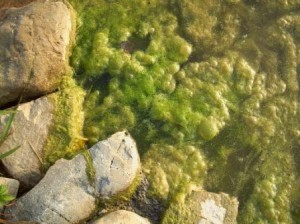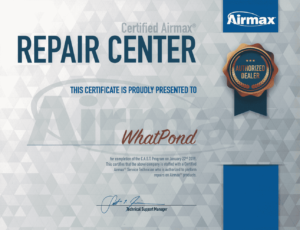Pond algae is the first thing to show up in the pond. In moderation it is healthy for the pond. Figure out the cause and cures in controlling pond algae. Let’s go over a couple that ruined the looks of our oasis, and how to control it. Different Types of Pond Algae: single cell, string/horsehair, and slime. Slime is a good sign. A coating on the sides and bottom are a sign of a healthy pond.
Plankton Pond Algae
This type is microscopic and free floating. This is what gives the green or pea soup look to the water. Plankton algae is mandatory for a healthy pond, they are at the base of the food chain and essential for aquatic life. When the first warming trend starts in the spring or early summer is when the bloom starts. As a rule of thumb to test the health of the water, put your arm in about 18” deep, if you can see your fingers, you’re in good shape.  Filamentous Pond Algae;
Filamentous Pond Algae;
Called string, hair, moss, or scum. The appearance on top of the water looks like a mat of various green colors and at times like a witches brew kind of boiling. Below the surface it looks like string or hair, even like sheets of cotton. Typically on the bottom it will be attached to dead decaying leaves or debris. Generally grows around the edges. By placing a rake on the bottom in the mass of this pond algae, twirl the rake around, as if it were spaghetti and pull it out, or just rake it out. It is a little tough to get off so stand on the strings and pull or cut it off the rake. As stated earlier, aquatic life feeds on pond algae so take a look for snails and other small creatures, at least replace the snails. Another great tool for removing algae is the Deskuzzer, toss it out, pull it in and empty.
What Causes Pond Algae To Grow.
There are three factors: excess nutrients, too much sunlight and low oxygen levels.
Nutrients come from fish and animal waste, fish food and decaying vegetation. Other sources from fertilizer and rain run off. All of these provide nitrogen and phosphorus that help pond algae to grow. Also having too much sunlight with little or no other aquatic plants will promote pond algae. Pond algae photosynthesize their food and takes needed oxygen from the water. The oxygen is needed to break down the waste from fish and dead vegetation.
Controlling Pond Algae.
Remove The Nutrients. Don’t over feed the fish clean the dead vegetation out and divert the run off. These plants will feed on the nutrients which help them grow and help provide needed oxygen. The fish also feed on these plants.
Reduce the amount of sunlight. This could be difficult if the pond is large and in the middle of a field. One option to use is pond dye, adding water lilies or lotus that would shade the surface. Smaller water gardens and ponds are a little easier to maintain as you can leave the plants in the container and trim as needed.
Mechanical aeration can be the most significant tool for controlling pond algae. Deeper ponds normally use a bottom diffuser while shallow ponds use surface aerators.
Another option in controlling algae is removing the nutrients, this is the muck and sludge accumulation build up at the bottom of the pond with the use of Beneficial Pond Bacteria’s.


Green muck on bottom of 900 gallon pond. Water seems a little cloudy but on the clear side.
How do I get rid of the muck?